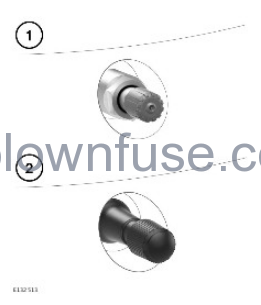
2022 Jaguar F-TYPE Tire Pressure Monitoring System (TPMS)

TIRE PRESSURE MONITORING SYSTEM (TPMS)
The Tire Pressure Monitoring System (TPMS) provides a low-pressure warning and does not re-inflate the tires. All tire pressures, including the spare, should be checked regularly using an accurate pressure gauge, when the tires are cold. Failure to do so may lead to accidents resulting in injury or death.
The TPMS cannot register damage to a tire. Regularly check the condition of the tires, especially if the vehicle is driven off-road. Failure to do so may lead to accidents resulting in injury or death.
The TPMS cannot predict, or warn of, a tire failure. Regularly check the condition of the tires, especially if the vehicle is driven off-road. Failure to do so may lead to accidents resulting in injury or death.
When inflating tires, care should be taken to avoid bending or damaging the TPMS valves. Always make sure that the inflation head is correctly aligned to the valve stem.
To avoid damage to the TPMS valves, it is recommended not to use rigid tire inflation wands. Stiff inflation wands increase the risk of excess leverage and sideways pressure on the valve.
Non-approved accessories may interfere with the TPMS. If this occurs, the instrument panel displays the message Tire Pressure Monitoring System fault.
Different types of tires may affect the performance of the TPMS. Always replace tires in accordance with recommendations. The vehicle is equipped with TPMS, which monitors pressure in each tire. Compact spare tires are not fitted with sensors and are consequently not monitored.

Wheels fitted with a TPMS can be visually identified by the external metal lock nut and valve (1). All Jaguar non-TPMS wheels have a rubber valve fitted (2).
At each tire change, a special service kit is required for each TPMS valve. Each tire, including the spare (if provided), should be checked monthly when cold and inflated to the inflation pressure recommended by the vehicle manufacturer on the vehicle placard or tire inflation pressure label. (If your vehicle has tires of a different size than the size indicated on the vehicle placard or tire inflation pressure label, you should determine the proper tire inflation pressure for those tires.) As an added safety feature, your vehicle has been equipped with a tire pressure monitoring system (TPMS) that illuminates a low tire pressure telltale when one or more of your tires is significantly under-inflated. Accordingly, when the low tire pressure telltale illuminates, you should stop and check your tires as soon as possible, and inflate them to the proper pressure. Driving on a significantly under-inflated tire causes the tire to overheat and can lead to tire failure. Underinflation also reduces fuel efficiency and tire tread life and may affect the vehicle’s handling and stopping ability. Please note that the TPMS is not a substitute for proper tire maintenance, and it is the driver’s responsibility to maintain correct tire pressure, even if under-inflation has not reached the level to trigger illumination of the TPMS low tire pressure telltale. Your vehicle has also been equipped with a TPMS malfunction indicator to indicate when the system is not operating properly. The TPMS malfunction indicator is combined with the low tire pressure telltale. When the system detects a malfunction, the telltale will flash for approximately one minute and then remain continuously illuminated. This sequence will continue upon subsequent vehicle start-ups as long as the malfunction exists. When the malfunction indicator is illuminated, the system may not be able to detect or signal low tire pressure as intended. TPMS malfunctions may occur for a variety of reasons, including the installation of replacement or alternate tires or wheels on the vehicle that prevents the TPMS from functioning properly. Always check the TPMS malfunction telltale after replacing one or more tires or wheels on your vehicle to ensure that the replacement or alternate tires and wheels allow the TPMS to continue to function properly.
TPMS lamp. See TIRE PRESSURE MONITORING SYSTEM (TPMS) (YELLOW). The tire pressure warning lamp illuminates when one or more of the tires is significantly under-inflated. Stop and check the tires as soon as possible, and inflate them to the recommended pressure for the vehicle’s loading condition. See TIRE PRESSURE MONITORING SYSTEM (TPMS) (YELLOW) and TIRE PRESSURES. Vehicles supplied with 20 in wheels also have a speed-based TPMS system. If the vehicle is required to travel at speeds of over 155 mph (250 km/h), the tire pressures should be raised. Failure to do this may cause the instrument panel displays the Tire pressures too low for a high-speed warning message. See TIRE PRESSURES.
Make sure to set the tire pressures to the correct pressure when the vehicle is traveling at speeds of less than 155 mph (250 km/h).
The instrument panel displays the TPMS warning lamp and related warning messages if a low tire pressure, or a fault, is detected.
The TPMS warning lamp operation and warning messages are as follows:
| Lamp operation and warning message | Issue | Action |
|---|---|---|
| The TPMS warning lamp illuminates for 3 seconds and then extinguishes. | Tire pressures are all correct. | No action is required. |
| The TPMS warning lamp illuminates permanently when the ignition is switched on. A low tire pressure warning message is displayed in the instrument panel. | One or more tire pressures are low. | Check and adjust the tire pressures of the tires shown in the instrument panel. |
| The TPMS warning lamp flashes for 75 seconds when the ignition is switched on, and then illuminates permanently. A warning message is displayed in the instrument panel to advise that a tire is not being monitored. A yellow cross appears on the tire in the warning message and in the Tire Pressures Menu. | The vehicle has lost communication with one of the tires. | Check and adjust all tire pressures, if required, before driving the vehicle. If the problem persists, contact a retailer/authorized repairer. |
| The TPMS warning lamp flashes for 75 seconds when the ignition is switched on, and then illuminates permanently. No warning message is displayed in the instrument panel. Two or more yellow crosses appear on the tires in the Tire Pressures Menu. | The vehicle has lost communication with more than one of the tires. | Check and adjust all tire pressures, if required, before driving the vehicle. If the problem persists, contact a retailer/authorized repairer. |
| The TPMS warning lamp flashes for 75 seconds when the ignition is switched on, and then illuminates permanently. No warning message is displayed in the instrument panel. No yellow crosses appear on the tires and no tire pressures are displayed in the Tire Pressures Menu. | Unknown fault with the TPMS. | Check and adjust all tire pressures, if required, before driving the vehicle. If the problem persists, contact a retailer/authorized repairer. |
TIRE PRESSURE CHECK
The instrument panel can be used to display the vehicle’s tire pressures. The tire pressure figures can be accessed via the Vehicle info and Tire information menus. See INSTRUMENT PANEL MENU OPERATION.
The tire pressure units can be configured to display as either bar, psi, or kPa via the Vehicle info and the Tire information menus.
When selected, the last known tire pressures are displayed, alongside the recommended cold tire pressures in brackets.
If any of the wheels or tires have been removed, the displayed tire pressures may not be valid. Drive the vehicle for at least 15 minutes in order to re-calibrate the system.
Tire pressures may not be displayed after the following actions:
- Disconnection of the vehicle’s battery.
- Repairs to the TPMS system.
The tire pressures are displayed after the vehicle is driven at 16 mph (25 km/h) for 5 to 10 minutes.
RECOMMENDED TIRE PRESSURE LOOK-UP
The instrument panel can display the recommended cold tire pressures for the vehicle. The tire pressure look-up table can be accessed via the Vehicle info and the Tire information menus. See INSTRUMENT PANEL MENU OPERATION. A number of different values may be displayed to reflect different driving conditions, e.g., high-speed driving or for a heavily laden vehicle. The display of the different values is dependent on vehicle specification.
TEMPORARY USE OF SPARE WHEEL AND TIRE CHANGE
If the temporary-use spare wheel is fitted, the system automatically recognizes the change in wheel positions. After approximately 10 minutes of driving above 16 mph (25 km/h), the instrument panel displays the Front(rear) Right(left) tire pressure not monitored message. The message is accompanied by the illumination of the Tire Pressure Monitoring System (TPMS) warning lamp. See TIRE PRESSURE MONITORING SYSTEM (TPMS) (YELLOW).
The TPMS warning lamp first flashes and then illuminates continuously. Extended use of the temporary-use spare wheel triggers the message Tire pressure monitoring system fault. The TPMS warning lamp display sequence activates at every ignition cycle until the temporary spare wheel is replaced by a full-size road wheel with a TPMS sensor fitted. The TPMS automatically re-calibrates when a full-size wheel is fitted to the vehicle, and the vehicle is driven above 16 mph (25 km/h) for approximately 5 minutes.
Contacting a retailer/authorized repairer is not required unless the TPMS lamp remains illuminated after the vehicle has been driven:
- with a full-size road wheel with a TPMS sensor fitted, and
- above 16 mph (25 km/h) for approximately 5 to 10 minutes.
Illumination of the TPMS lamp is normal behavior for the vehicle when a temporary-use spare wheel is fitted and is not a cause for concern.
TYPE APPROVAL NUMBERS
Tire Pressure Monitoring System (TPMS):
This device complies with part 15 of the FCC rules. Operation is subject to the following two conditions:
- This device may not cause harmful interference, and
- this device must accept any interference received, including interference that may cause undesired operation.
This device complies with Industry Canada Standard IC – RSS-210. Operation is subject to the following two conditions:
- this device may not cause interference, and
- this device must accept any interference, including interference that may cause undesired operation of the device.
Changes or modifications, not expressly approved by the manufacturer, could void the user’s authority to use the equipment.
The 433 MHz TPMS Radio Frequency (RF) approval numbers for the USA and Canada are:
| USA FCC ID: | KR5S180052020A |
| 5WK49096 | |
| Canada IC: | 7812D-S180020A |
| 267T-5WK49096 |
